Recipe for Datil Pepper Sauce
In the heart of St. Augustine, Florida, the datil pepper is a treasured ingredient. It’s known for its unique taste and spicy kick. This pepper is the main ingredient in a sauce that’s a big part of the city’s food scene. Our Recipe for Datil Pepper Sauce will take you on a flavorful trip to St. Augustine. Here, every bite brings the spirit of the coastal community to life.
Datil peppers have a fruity taste and a strong heat. By mixing them with other flavors and spices, you’ll make a sauce that can spice up many dishes. It’s perfect for both traditional Florida dishes and new, creative recipes.
Table of Contents
Key Takeaways
- Datil peppers are a unique ingredient native to St. Augustine, Florida, known for their fruity flavor and fiery heat.
- This recipe showcases the datil pepper in a signature sauce that has become a beloved part of St. Augustine’s culinary heritage.
- The sauce can be used to add a bold, spicy kick to a variety of dishes, from classic Florida cuisine to modern fusion recipes.
- Carefully balancing the datil peppers with complementary ingredients is the key to creating a well-rounded, versatile sauce.
- Mastering this recipe will allow you to bring the authentic taste of St. Augustine into your own kitchen.
Introduction to Datil Peppers and Their Unique Flavor Profile
In St. Augustine, Florida, you’ll find a special pepper called the datil pepper. These small peppers have a fruity taste and a spicy kick. They are key to the local food scene, leading to a big Florida hot sauce market and exciting many spice lovers.
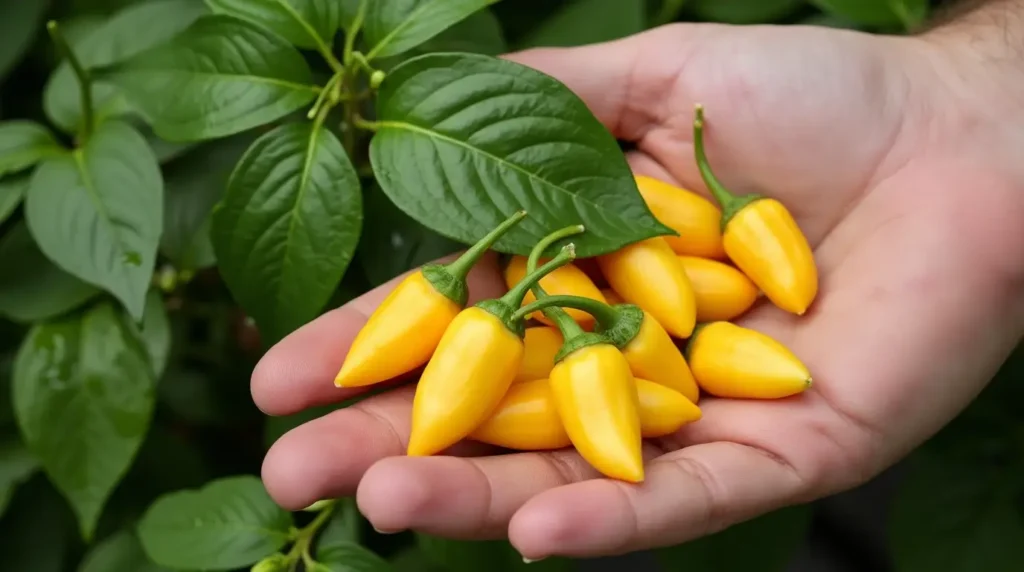
History of Datil Peppers in St. Augustine
The datil pepper started in the late 1800s, brought by Minorcan settlers to St. Augustine. They grew well in the area’s warm weather. Today, the datil pepper is a big part of St. Augustine’s food history, inspiring many to make spicy condiments.
Understanding the Heat Level and Taste
The datil pepper packs a punch, with heat levels from 100,000 to 300,000 Scoville Heat Units (SHU). It’s as hot as habaneros but tastes fruity and sweet. This mix of heat and flavor makes it great for many dishes.
Compared to other hot peppers, the datil pepper stands out. Its taste, with hints of apricots or mangoes, and its heat, make it perfect for Florida hot sauces, marinades, and more.
Essential Equipment and Tools for Making Datil Pepper Sauce
Making the perfect datil pepper sauce needs more than just ingredients. You need the right tools for a smooth, flavorful sauce. Whether you’re experienced or new to cooking, knowing the tools will help you succeed in making datil pepper sauce and hot sauce recipes.
You’ll first need a good blender or food processor. This is for blending the peppers and other ingredients into a smooth mix. Choose a strong model that can handle the tough datil peppers. Also, a fine-mesh strainer or sieve is key for removing seeds and skin, making the sauce silky.
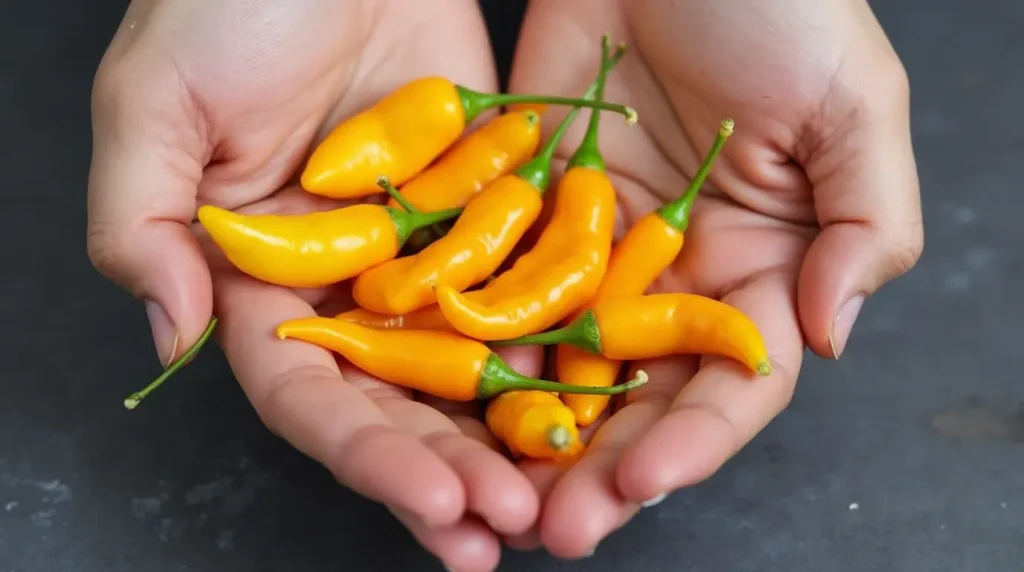
- High-powered blender or food processor
- Fine-mesh strainer or sieve
- Airtight storage bottles or jars
- Protective gloves (nitrile or latex)
- Cutting board and sharp knife
Datil peppers are very potent, so wear protective gloves when handling them. This prevents skin irritation or discomfort. You’ll also need a clean cutting board and sharp knife for preparing the peppers.
Finally, get airtight storage bottles or jars for your datil pepper sauce. This keeps the flavor and texture good for later use. You can enjoy it for weeks or months.
With the right tools, you’re ready to make a datil pepper sauce that showcases these special peppers. Enjoy the process and let your creativity shine in your hot sauce recipes.
Recipe for Datil Pepper Sauce: Ingredients Overview
Making a tasty datil pepper sauce begins with picking the right ingredients. You can choose between fresh or dried datil peppers. Each has its own benefits. You can also mix different base ingredients and spices to make the sauce your own.
Fresh vs. Dried Datil Peppers
Fresh datil peppers give a strong, lively taste and a bit more heat. Dried peppers pack a more intense flavor and are easier to use when fresh peppers are hard to find. It’s up to you whether you prefer the fresh or dried peppers, based on how spicy you like your sauce.
Base Ingredients and Aromatics
- Onions: Add depth and sweetness to the sauce.
- Garlic: Enhances the overall aroma and flavor profile.
- Vinegar: Provides a tangy balance to the heat of the datil peppers.
- Olive oil or butter: Helps to bind the ingredients and creates a smooth texture.
- Salt and pepper: Season the sauce to your taste preferences.
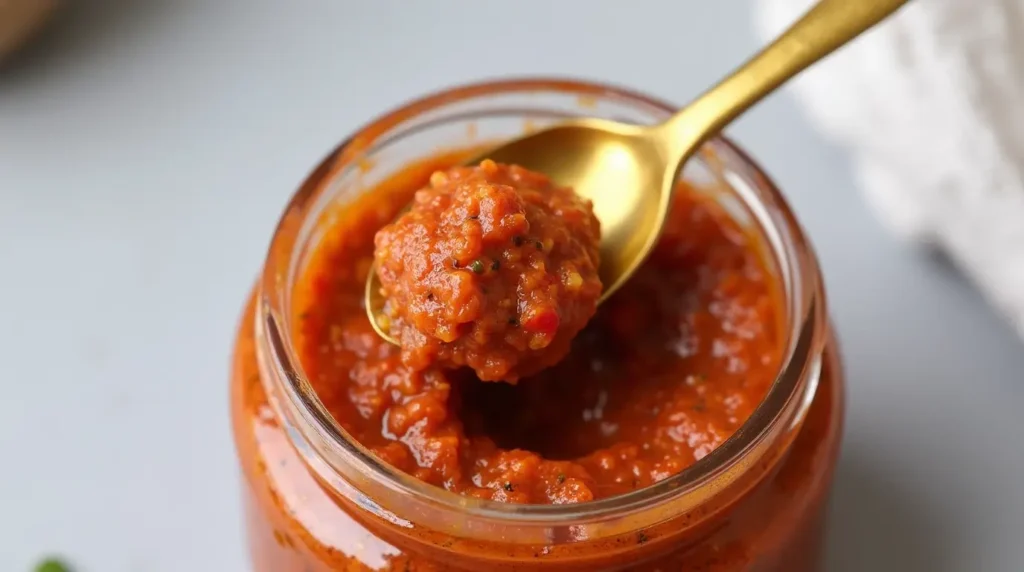
Optional Flavor Enhancers
To make your recipe for datil pepper sauce even better, try adding these:
- Herbs: Fresh or dried basil, oregano, or cilantro can add a herbaceous note.
- Spices: Cumin, paprika, or chili powder can complement the datil pepper’s heat.
- Sweeteners: A touch of honey, brown sugar, or molasses can balance the sauce’s heat.
- Citrus: A splash of lime or lemon juice can brighten the overall flavor.
Knowing about the datil pepper sauce ingredients lets you make a sauce that’s just right for you.
Safety Precautions When Handling Datil Peppers
When working with datil peppers, it’s crucial to take proper safety precautions. These peppers pack a powerful punch. You’ll want to handle them with care to avoid any unpleasant experiences.
Always wear protective gloves when handling datil peppers. They contain capsaicin, the compound responsible for their intense heat. This can easily irritate your skin. Avoid touching your face, eyes, or any other sensitive areas while working with the peppers.
Proper ventilation is also key when making datil pepper sauce. The aroma and fumes from the peppers can be potent. Make sure to work in a well-ventilated area or turn on your kitchen exhaust fan. Avoid leaning directly over the peppers, as the fumes can cause respiratory irritation.
Eye protection is another important safety measure. Wearing goggles or a face shield can help prevent the pepper’s oils from getting into your eyes. This can cause a painful burning sensation.
- Wear protective gloves to avoid skin irritation
- Ensure proper ventilation to prevent respiratory issues
- Use eye protection to safeguard against pepper fumes
By taking these simple precautions, you can safely enjoy the unique and flavorful experience of working with datil peppers. You can create your own delicious datil pepper sauce.
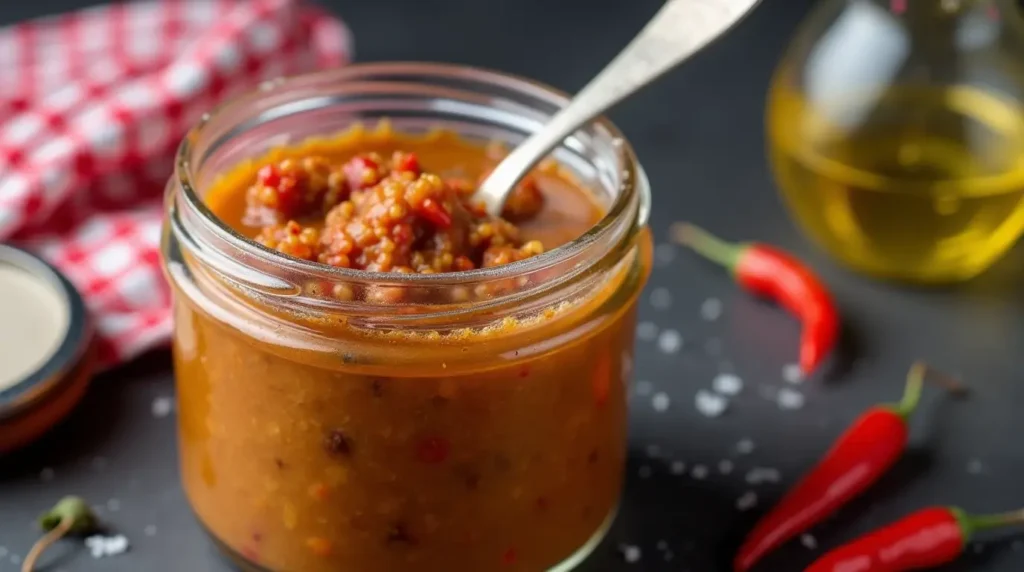
Preparing Your Datil Peppers for the Sauce
Before making your delicious datil pepper sauce, you need to prepare the datil peppers. Cleaning, trimming, and storing them right is key for the best flavor and freshness.
Cleaning and Trimming Tips
Wash each datil pepper under cool water, scrubbing gently to remove dirt. Don’t cut or slice them yet, as it can reduce their flavor and heat. After washing, trim the stem end with a sharp knife, leaving a bit of stem.
Proper Storage Methods
- For fresh datil peppers, put them in a resealable bag or airtight container. Refrigerate to preserve its remarkable freshness and exceptional flavor for up to an entire week.
- If using dried datil peppers, keep them in an airtight container in a cool, dark spot for up to 6 months.
- To freeze fresh peppers, slice or chop them first. Place them on a baking sheet to freeze, then move to an airtight container or bag. Store for up to 12 months.
By following these steps, your datil peppers will be ready to add their unique flavor and heat to your homemade sauce.
Step-by-Step Cooking Process
Making the perfect datil pepper sauce needs careful steps. Follow these tips to get a tasty and balanced sauce. It will highlight the special taste of the datil pepper.
- Start by getting your datil peppers ready. Wear gloves to avoid skin irritation. Clean and trim the peppers, removing stems and seeds if you like. See the previous section for more on pepper prep.
- In a saucepan, mix the cleaned datil peppers with your base ingredients. Use vinegar, olive oil, and aromatics like onions and garlic. You can adjust the amounts to your taste.
- Heat the mix gently over medium heat, stirring now and then. Let it cook for 15-20 minutes. This step blends the flavors and softens the peppers.
- When the peppers are soft, move the mix to a blender or food processor. Blend until it’s smooth and even. Adjust the texture flawlessly by increasing or reducing the amount of liquid to achieve your desired consistency.
- Strain the blended datil pepper sauce through a fine-mesh sieve. Press on the solids to get as much flavor as you can. Throw away the solids.
- Put the strained sauce back in the saucepan. Simmer for 5-10 minutes more. This lets the flavors mix and the sauce thicken a bit.
- Try the datil pepper sauce and tweak the seasoning if needed. Add salt, acidity, or sweetness to get the flavor just right.
By carefully following these steps, you’ll make a datil pepper sauce that’s full of flavor. Be gentle with the peppers and adjust the recipe to your taste.
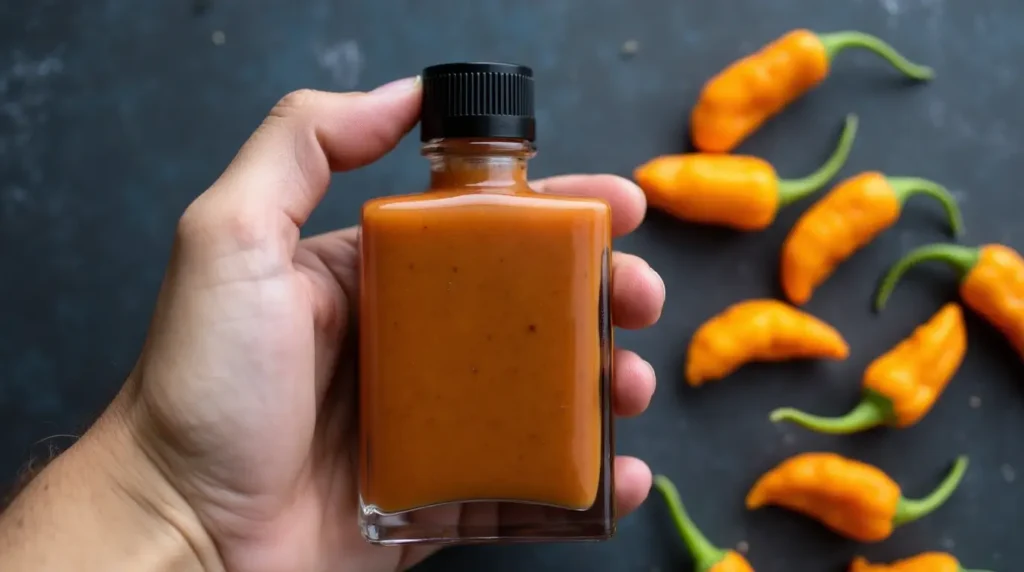
Blending and Straining Techniques
Making the perfect datil pepper sauce needs careful blending and straining. These steps are key for the right consistency and flavor mix. Whether you’re experienced or new to datil pepper, learning these techniques will make your recipe for datil pepper sauce better.
Achieving the Perfect Consistency
For a smooth datil pepper sauce, start by blending cooked datil peppers and other ingredients well. Use a high-powered blender or food processor. Slowly increase the speed to avoid lumps.
To get an even smoother sauce, strain it through a fine-mesh sieve or cheesecloth. This removes seeds and skin, making the sauce silky and creamy.
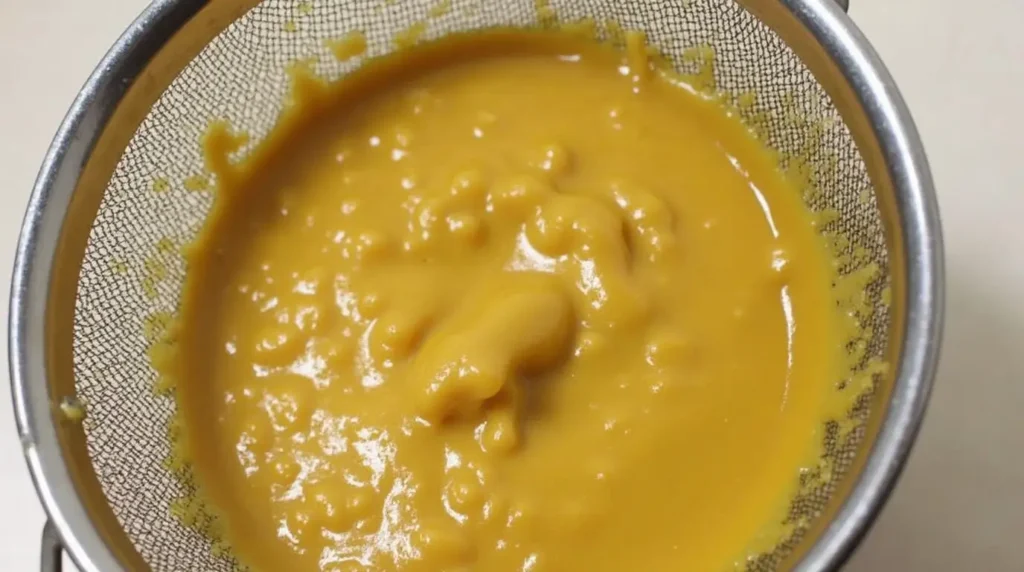
Troubleshooting Common Issues
- If your datil pepper sauce is too thin, simmer it to reduce moisture.
- To thin a thick sauce, add a bit of cooking liquid, vegetable broth, or water.
- For an off-flavor, adjust by adding more datil peppers, aromatics, or seasonings.
Perfecting the recipe for datil pepper sauce takes patience and attention to detail. With practice, you’ll get the consistency and flavor right, enhancing your dishes.
Bottling and Storage Guidelines
Keeping your homemade datil pepper sauce recipe fresh and flavorful is crucial. It ensures the sauce stays a delightful condiment for months. Proper bottling and storage are key to keeping the sauce’s color, aroma, and spicy kick.
Start by cleaning and sterilizing your bottles or jars. This step prevents harmful bacteria and extends the sauce’s shelf life. Use a dishwasher or wash them with hot, soapy water, then rinse and dry them well.
When sealing your spicy condiments, choose airtight lids or caps. They keep the freshness in and prevent oxidation, which can reduce flavor. For extra security, use a vacuum sealer or heat-shrink bands for a tight, tamper-evident seal.
| Bottling Step | Recommended Technique |
|---|---|
| Sterilization | Dishwasher or manual wash with hot, soapy water |
| Sealing | Airtight lids, vacuum sealing, or heat-shrink bands |
| Storage | Refrigerator or cool, dark place |
For the best storage, keep your datil pepper sauce recipe in the fridge or a cool, dark spot. Avoid direct sunlight or too much heat, as it can spoil the sauce faster and lower its quality.
Flavor Variations and Customization Options
The datil pepper’s unique flavor is perfect for trying new things. You can make a datil pepper sauce that’s just right for you. Whether you love Florida hot sauces or want to make your own, you can do it.
Want to try something new? Add these to your datil pepper sauce:
- Fruits: Mango, pineapple, or citrus fruits can add a delightful sweetness and tropical flair to your sauce.
- Herbs: Fragrant herbs like oregano, cilantro, or basil can enhance the overall aroma and depth of flavor.
- Spices: A touch of cumin, smoked paprika, or garlic powder can lend an earthy complexity to your datil pepper sauce.
For a more robust and complex flavor profile, you could also experiment with the addition of:
- Roasted bell peppers
- Caramelized onions
- Ginger or lemongrass
- Honey or maple syrup
Finding the perfect datil pepper sauce is all about balance. Mix the pepper’s heat with your favorite ingredients. Taste and adjust until it’s just right.
| Flavor Combination | Suggested Ingredients | Culinary Applications |
|---|---|---|
| Tropical Twist | Datil peppers, mango, pineapple, cilantro | Marinades, dipping sauces, glazes for grilled meats or seafood |
| Smoky and Savory | Datil peppers, roasted bell peppers, smoked paprika, garlic | Chili, barbecue sauces, burgers, meatloaf |
| Sweet and Heat | Datil peppers, honey, brown sugar, cinnamon | Breakfast dishes, desserts, cocktails |
Let your creativity run wild with the datil pepper. Try new flavors to make a sauce that’s all yours. It will elevate your culinary skills to extraordinary heights, unlocking a world of remarkable flavors and techniques.
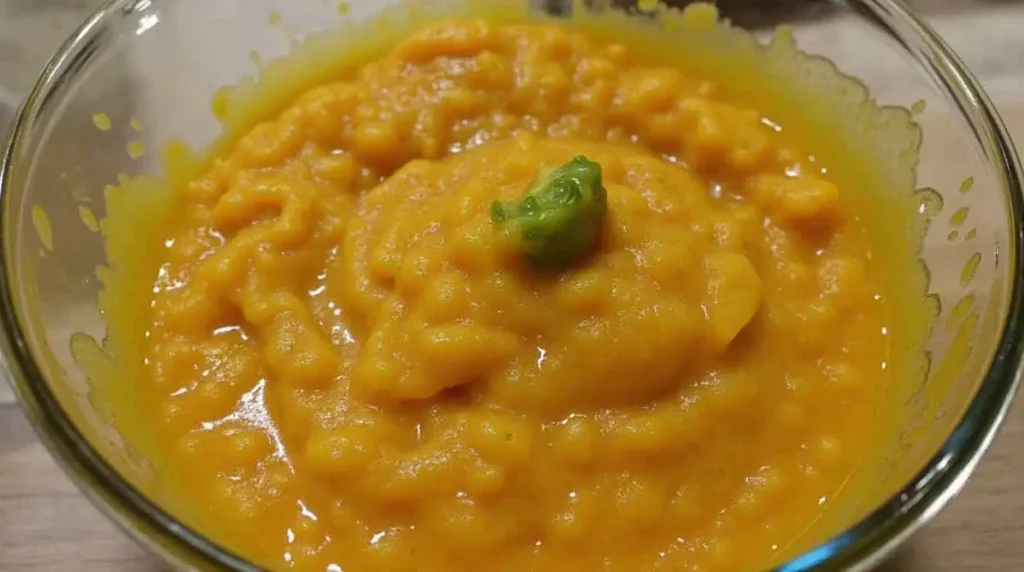
Pairing Suggestions and Culinary Applications
Datil pepper sauce is a versatile condiment that can elevate a wide range of traditional Florida dishes as well as modern fusion cuisine. Its unique flavor profile, with a subtle sweetness and a distinct heat, makes it an ideal complement to various meats, seafood, and vegetable-based recipes.
Traditional Florida Dishes
Datil pepper sauce pairs exceptionally well with classic Florida cuisine, such as grilled or blackened fish, shrimp and grits, and the iconic Cubano sandwich. It can also add a flavorful twist to traditional gumbo or jambalaya dishes, which are popular in the region’s coastal communities.
Modern Fusion Applications
Beyond traditional fare, datil pepper sauce can be used to create exciting fusion dishes that blend the flavors of St. Augustine with global influences. Try incorporating it into stir-fries, tacos, or burgers for a unique and spicy kick. It also complements roasted vegetables and grilled meats beautifully, adding depth and complexity to the overall dish.
| Dish | Pairing Suggestion |
|---|---|
| Grilled Fish | Brush datil pepper sauce on the fish before grilling for a flavorful crust. |
| Shrimp and Grits | Drizzle datil pepper sauce over the shrimp and grits for a spicy twist. |
| Cubano Sandwich | Use datil pepper sauce as a condiment on the Cubano for an authentic St. Augustine flavor. |
| Stir-Fry | Incorporate datil pepper sauce into the stir-fry sauce for a unique Asian-Florida fusion. |
Regardless of the dish, datil pepper sauce can elevate the flavors and provide a delightful heat that complements the St. Augustine cuisine. Experiment with its versatility and discover new ways to incorporate this distinctive condiment into your culinary adventures.
Tips for Adjusting Heat Levels
Creating the perfect datil pepper sauce is all about finding the right mix of heat and flavor. Whether you like it mild or fiery, these tips will guide you to adjust the spice to your liking.
Increasing the Heat
For a spicier hot sauce recipe, try these methods:
- Use more datil peppers in your sauce, either fresh or dried.
- Experiment with hotter pepper varieties, such as habaneros or ghost peppers, to complement the datil pepper flavor.
- Leave the seeds and membranes intact when processing the peppers, as these components contain the majority of the capsaicin.
- Add a splash of hot sauce or chili oil to the finished sauce for an extra kick.
Taming the Heat
If your datil pepper sauce is too spicy, try these methods to tone it down:
- Use fewer datil peppers or substitute with milder bell peppers.
- Remove the seeds and membranes from the datil peppers before processing to reduce the capsaicin content.
- Increase the amount of non-spicy ingredients, such as tomatoes, onions, or garlic, to dilute the overall spice level.
- Stir in a bit of cream, yogurt, or other dairy product to temper the heat.
Remember, finding the perfect balance of heat and flavor is a matter of personal preference. Experiment with these tips to create a datil pepper sauce that tantalizes your taste buds just the way you like it.
Shelf Life and Preservation Methods
Knowing how long your homemade datil pepper sauce lasts is key. Its shelf life depends on a few things. But with the right storage, you can keep its flavor and quality for months.
Signs of Spoilage
Watch for signs that your sauce might be spoiled. Look for color, consistency, or smell changes. If you see mold, bad smells, or a slimy feel, throw it away and make a new batch.
Best Storage Practices
- Use airtight containers, like glass or food-grade plastic, to keep air out and freshness in.
- Keep it in the fridge to slow down bad bacteria growth and extend its life.
- Don’t let it sit in direct sunlight or heat, as it can lose flavor and quality.
- Freezing it can make it last even longer. Just thaw it slowly before using.
| Preservation Method | Estimated Shelf Life |
|---|---|
| Refrigerated | 3-6 months |
| Frozen | 6-12 months |
By storing it right, you can enjoy your homemade datil pepper sauce for months. It’s great in many spicy condiments and datil pepper sauce recipes.
Common Mistakes to Avoid
Making the perfect datil pepper sauce is a fun journey in the kitchen. But, it’s key to watch out for common mistakes. Knowing these can help your hot sauce recipes always come out right.
One big mistake is adding too much seasoning. Datil peppers are very spicy. So, it’s important to find the right mix of heat and flavor. Too much heat can make the sauce hard to enjoy.
Another issue is not blending the sauce right. You need to blend it well to get a smooth texture. If you rush or use the wrong tools, you might end up with a sauce that’s not smooth.
- Avoid overseasoning the sauce with too many datil peppers
- Blend the sauce thoroughly to achieve the desired smooth consistency
- Ensure you follow proper safety precautions when handling the peppers
Lastly, don’t forget about safety when working with datil peppers. They are very spicy and can irritate your skin and eyes. Always wear gloves, work in a well-ventilated area, and wash your hands well after handling the peppers.
By avoiding these mistakes, you’ll make a datil pepper sauce that’s tasty and shows off your cooking talent.
Conclusion
Making the perfect datil pepper sauce is a fun journey. It’s a special dish from St. Augustine, filled with vibrant flavors and history. By learning how to use these hot peppers, you can make a sauce that truly captures Florida’s coastal taste.
Don’t be afraid to try new things with datil peppers. You can stick to a classic recipe or add your own twist. Just remember to be careful when handling these strong peppers. Also, keep your homemade sauce in a good place to keep it fresh.
We hope this guide has sparked your interest in datil peppers. It’s a chance to bring St. Augustine’s unique taste to your kitchen. Enjoy the unique heat and depth of this special ingredient. Share your creations with others and have fun exploring the world of datil pepper sauce and St. Augustine cuisine.
FAQ
What is the history of datil peppers in St. Augustine, Florida?
Datil peppers have a rich history in St. Augustine. They were brought by Spanish colonists. Now, they’re a beloved part of local cooking.
How hot are datil peppers compared to other popular hot peppers?
Datil peppers are quite hot, with a Scoville Heat Unit range of 5,000 to 10,000. They’re hotter than jalapeños but milder than habaneros. They also have a fruity flavor that’s unique.
What essential equipment and tools are needed to make datil pepper sauce?
You’ll need gloves, a blender or food processor, a fine-mesh strainer, and clean bottles or jars. These tools help make the sauce.
Can I use fresh or dried datil peppers in the sauce recipe?
Yes, you can use both fresh and dried datil peppers. Fresh ones give a vibrant flavor, while dried ones offer a deeper heat. It depends on your taste and the dish.
What safety precautions should I take when handling datil peppers?
Protect yourself by wearing gloves and ensuring you’re in a well-ventilated space to prevent any discomfort or irritation. Exercise caution and avoid touching your eyes or face to prevent irritation or discomfort.
How do I properly store and prepare datil peppers for the sauce?
Clean and trim the peppers, removing stems, seeds, and blemishes. Store fresh peppers in the fridge in an airtight container. Store dried peppers in a cool, dark, and dry location to maintain their exceptional quality and robust flavor.
What is the step-by-step process for making datil pepper sauce?
First, prepare the ingredients. Then, sauté the aromatics. Add the peppers and seasonings. Simmer to develop flavors. Blend and strain for the right consistency.
How can I achieve the perfect consistency for my datil pepper sauce?
Blend the sauce in a high-powered blender or food processor. Strain it through a fine-mesh strainer. Adjust the ingredients to get the perfect texture.
How should I store and preserve my homemade datil pepper sauce?
Store the sauce in clean, sterilized bottles or jars. Keep it in the fridge for 2-3 months. Check for signs of spoilage before using.
Can I customize the flavor of my datil pepper sauce?
Yes! You can add fruits, herbs, or spices to create unique flavors. Try mango, pineapple, cilantro, or cumin to enhance the sauce.
What are some traditional and modern ways to use datil pepper sauce?
Traditionally, it’s used in seafood, chicken, or pork dishes. But you can also use it in tacos, burgers, eggs, or as a marinade or dipping sauce.
How can I adjust the heat level of my homemade datil pepper sauce?
Adjust the heat by changing the amount of peppers or removing seeds and membranes. You can also add vinegar, citrus, or sweeteners to balance the heat.
How long will my homemade datil pepper sauce last, and what are the best storage practices?
It can last 2-3 months in the fridge. Store it in clean, sterilized containers with tight lids. Check for signs of spoilage before using.
What are some common mistakes to avoid when making datil pepper sauce?
Avoid not wearing gloves, overcooking, not adjusting the heat, not straining well, and poor storage. These mistakes can ruin the sauce.








One Comment